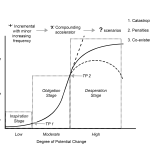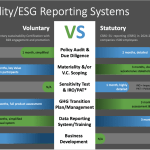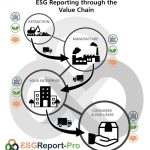The Key to Circulatory?
ESG reporting certainly generates paperwork, quite a bit of anxiety too, but aside from producing reports, is there really any mission or purpose to it all? Many argue that it has become a pivotal tool for assessing a company’s impact on the world. Has it? Really? Sounds a bit far-fetched to say that by simply making a report that a company is actually assessing it’s impacts and possibly creating good ones, let alone making the world at large a better place.
Take a Step Back
Maybe we can take a step back and try to see the wood for the trees? At the heart of ESG reporting is the recognition that the value chain, which includes all stages of a product or service lifecycle, plays a crucial role in determining a company’s environmental and social footprint. But in most cases, the value chain participants exist before an organisation is created, the businesses are already there doing their thing and an organisation comes along and starts transacting with them. So, they already have impacts and its the degree of change of those impacts that should concern members of the overall chain. And at the heart of that, are the workers within the value chain, they are the folks who will be managing new impacts, and I’d argue that they are in fact the starting point of any genuine, accurate ESG report.
If we begin there, can we say that there is an all-consuming goal? If we see the forest as a whole, what is its purpose? This isn’t an existential question, it’s real and tangible, and I’d suggest that the whole point of ESG reporting, the raison d’etre, is to establish a circular economy. Here’s my thinking…
Labour Practices, Social Impact and Social Contract
Up and down your value chain workers are engaged with the production, distribution, and delivery of goods and services, and are therefore integral to the social aspect of ESG reporting. Fair labour practices, occupational health and safety, and employee well-being are key components that reflect a company’s commitment to its workforce. ESG reporting begins by assessing the treatment of value chain workers, examining factors such as working conditions, job security, diversity, and opportunities for professional development. But as we discussed in a previous article about Meaningfulness your engagement with your value chain has a deeper collaborative connection that should be driving positive impacts and forms the basis of a social contract that binds all participants in your organisation and value chain to creating better conditions and a healthier planet.
Supply Chain Transparency and Ethical Conduct
Completing your internal ESG reporting could be problematic, but it is likely to be child’s play compared to your value chain. In another of our articles, Dirty Double Data, we emphasise the risks and solutions to supply chain transparency, which is a cornerstone of ESG reporting, and value chain workers play a pivotal role in ensuring the ethical and responsible sourcing of materials and services. Companies must provide visibility into their supply chains, from raw material extraction all the way through to end-of-life management, addressing issues like child labour, forced labour, and environmental degradation. Reporting on supply chain practices involves not only the acknowledgment of potential risks but also the implementation of measures to mitigate those risks, safeguarding the rights and well-being of workers.
ESG reporting goes beyond conventional financial metrics, emphasising the protection of human rights and ethical conduct throughout the value chain. Companies must demonstrate a commitment to avoiding complicity in human rights abuses and unethical practices, with a particular focus on regions where value chain workers may be vulnerable to exploitation. Reporting on human rights considerations involves comprehensive assessments and actions to rectify any identified issues, ensuring a fair and ethical treatment of workers across the entire value chain. Critically, this is not a static process, it keeps changing and hopefully for the better. It should therefore be no surprise that your approach to ethics is often reflected in your value chains’ approach – “A man is judged by his friends, for the wise and the foolish have never agreed.” — Baltasar Gracián.
Embedding Sustainability in Value Chain Operations
It is likely that organisations are going to have to make some tough calls about their value chain partners. Relationships that have stood the test of time may not stand the test of ESG ethical conduct. Commitment and transparency will be challenged by duplicity and cunning, and that’s just concerning data. Embedding sustainability throughout your value chain will become an ongoing process that can be a deal-maker or breaker. What should you be looking for?
Start by assessing a value chain partner’s commitment to climate action, energy efficiency, and waste reduction by asking their workers, particularly those involved in manufacturing and logistics, about how they implement sustainable practices that reduce the overall carbon footprint and environmental impact. Have they adopted eco-friendly production methods, reduced waste, and incorporated recycled or renewable materials? Sustainable sourcing and production are essential aspects of ESG reporting, ensuring that the environmental impact is minimised throughout the entire value chain. What you want to know is, how do they plan (if at all) to improve? Try using some technology to help monitor and evaluate initiatives, ESG Report Pro can help here, especially those concerning resource utilisation and optimisation, waste minimisation, and general sustainability KPIs.
Extended Producer Responsibility (EPR)
Maybe you can see my drift? A circular economy seeks to minimise waste, promote resource efficiency, and extend the life cycle of products. ESG reporting acts as a catalyst for transitioning towards a circular economic system by encouraging companies to adopt circular economy principles in their value chain operations – in fact, to shift the entire value chain towards circularity. This involves designing products for durability, repairability, and recyclability, as well as promoting circular supply chain practices.
Those efforts to engage with your value chain workers on social measures, particularly those involved in product design, manufacturing, and end-of-life management, play a crucial role in implementing EPR measures. This includes designing products with recycling in mind, facilitating take-back programs, and ensuring responsible disposal and recycling practices. It is obvious that they therefore become the drivers of innovation and best practice for minimising waste generation, optimising resource use, and prioritising the reuse and recycling of materials. ESG reporting encourages companies to set targets for waste reduction, track progress, and implement initiatives that align with circular economy principles, and it’s your value chain workers who will have the greatest impact on your own ESG reporting.
So Why Isn’t the World Circular?
While ESG reporting acknowledges the importance of value chain workers, challenges persist in ensuring labour rights, social equity and direct engagement across diverse global supply chains. Companies face the task of addressing sensitive issues such as fair wages, working hours, and occupational safety for workers in different regions and through various perspectives. ESG reporting should not only highlight the positive aspects of labour practices but also transparently address challenges and outline strategies for improvement. Unfortunately, the somewhat up-front, even confrontational, approach by ‘Western’ cultures is not always appreciated in other countries.
Accurate ESG reporting requires comprehensive data collection, especially concerning value chain operations, we discussed this at length in Dirty Double Data. Ensuring transparency throughout the value chain can be challenging, particularly when dealing with complex and multi-tiered supply chains. Companies need to invest in robust data management systems and engage with suppliers to enhance transparency, monitor improvements and drive innovation towards generating a circular economy. But that often involves upfront costs and potential trade-offs with short-term profitability. Your value chain partners may well need support and encouragement in how to balance financial considerations with long-term sustainability goals. Demonstrating the business case for sustainability and outlining the financial benefits of adopting circular economy principles can strengthen the integration of value chain workers into ESG reporting.
Your Value Chain is the Key to Circularity
ESG reporting is a dynamic process that begins with the acknowledgment of the pivotal role played by value chain workers in shaping a company’s environmental, social, and governance practices. By first focusing on fair labour practices, supply chain transparency, and the well-being of value chain workers, ESG reporting lays the foundation for sustainable and responsible business operations. Furthermore, ESG reporting acts as a driving force towards the ultimate goal of developing a circular economic system. Value chain workers are instrumental in embedding sustainability in operations, reducing environmental impact, and fostering a transition towards circular economy principles. While challenges exist, the integration of value chain workers into ESG reporting offers an opportunity to create a more equitable, sustainable, and resilient global economy. As companies navigate the complexities of their value chains, ESG reporting serves as a compass, guiding them towards a future where economic success is intertwined with social responsibility and environmental stewardship. In other words, choose your friends wisely.





